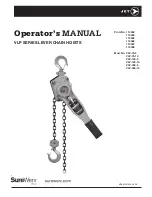
© Guldmann
GB/US
-09/2016 •
#550376_3
164
CONTROL
Checkliste
Slings
Examples of defective slings:
Broken stitching
Knots
Crushed/frayed webbing
Melting/charring
Periodic Inspection according
to DS/EN ISO 10535:2006
Guidance for 6-month inspection of slings
Sling inspection technique
The sling inspection procedure
should be thorough, systematic
and consistent; both visual and
“hands on” inspection techniques
are recommended.
Certain forms of damage are far
more discernable through hands-
on inspection, than by visual
inspection. For example, fabric
stiffness, crushed webbing, as well
as thinning fabric can be identified
through tactile inspection. Visual
inspection alone may not reveal all
forms of sling damage.
Once signs of damage have been
identified, do not downgrade the
work load limit of the sling with the
intent of continuing to use it, but at
limited capacity or frequency. This
is sometimes done to get more
service life out of a damaged sling.
The operating rule and standard
should be: intact = use; damage
= do not use.
Consider the practice of docu-
menting sling inspections through
written inspection records. The
documen tation should include
information such as: the name
of manufacturer, the sling stock
number, width and length, the
unique sling identification number
(important in differentiating similar
slings), as well as the condi tion of
the sling. Other important informa-
tion might also include the date
it was received or put into use at
your facility and any special fea-
tures (if applicable).
Considerations for damaged or
defective slings and taking them
out of service:
Consider removal of slings from
service if any of the following con-
ditions exist:
1. chemical or caustic burns
2. melting or charring of any part
of the sling
3. snags, punctures, tears or cuts
4. broken or worn stitches
5. missing, illegible or incomplete
sling tag
6. knots in any part of the sling
7. abrasion
8. other visible damage that
causes doubt as to the strength
of the sling
Sling inspection is done for the
protection of the patient, the care-
giver, and the overall hospital site
safety. A sling inspection system
has additional benefit. Systematic
sling inspection will assist in the
identifi cation of damage trends,
potentially leading to cost effec-
tive suggestions and results. The
inspection process can also help
to identify inventory duplicity in
certain sling types and sizes.
NB:
Inspections should be perfor-
med by a person who is suitably
and properly qualified and well
acquainted with the design, use
and care of the slings.
Guldmann is offering a
training program in Inspection
of Slings according to
DS/EN ISO 10535:2006
Summary of Contents for GH1 F
Page 20: ... Guldmann GB US 09 2016 550376_3 22 GENERAL INFORMATION ...
Page 151: ... Guldmann GB US 09 2016 550376_3 153 TECHNICAL DRAWINGS Jumper settings GH3 GH3 Twin ...
Page 158: ... Guldmann GB US 09 2016 550376_3 160 TECHNICAL DRAWINGS ...
Page 164: ... Guldmann GB US 09 2016 550376_3 166 NOTES ...
Page 165: ... Guldmann GB US 09 2016 550376_3 167 NOTES ...
Page 166: ... Guldmann GB US 09 2016 550376_3 168 NOTES ...


































